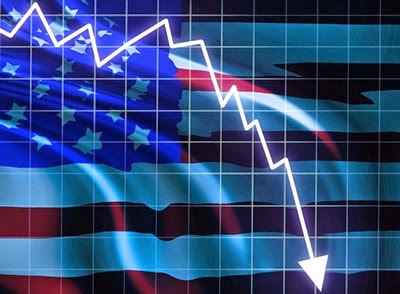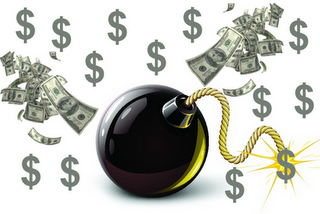What Economic Elites Don’t Want You to Know about Crashes
A 1921 event will change your understanding of depressions by Douglas French:
The Great Recession drags on everywhere except for Wall Street, Washington, DC, and Ben Bernanke’s consciousness. “By stabilizing the financial system, we avoided much, much worse, persistently bad consequences for our economies,” Bernanke said in an interview with his old friend Mervyn King (former head of the Bank of England) on the BBC.
Bernanke says he was stimulated by the opportunity to open up his monetary bag of tricks. “I feel that the work I did as an academic paid off and that I was able to use that to help solve these problems,” he said. “That’s very satisfying, though it’s not an experience I would voluntarily repeat.”
Maybe it’s paying off for Bernanke as he makes $200,000 per speech, but for the rest of us, not so much. The former Fed chair famously told Milton Friedman the central bank wouldn’t make the same mistakes as the 1930s Fed. From his analysis, Bernanke thinks the central bank tightened the money supply in the ‘30s to cause the Great Depression. That lesson prompted him after the 2008 crash to unleash a barrage of rounds of quantitative easing and an Operation Twist while quadrupling the central bank’s balance sheet to “stabilize the financial system.”
Jim Grant sees it differently, thinking Bernanke and company should have kept their hands off the money supply and interest rates. Grant, the financial world’s foremost wordsmith, provides the depression of 1920–21 as his evidence.
His book The Forgotten Depression: 1921: The Crash That Cured Itself chronicles how the market works marvels if left alone. Grant tells the reader right away, “The hero of my narrative is the price mechanism, Adam Smith’s invisible hand.”
Yes, there was a Treasury and a still-new Federal Reserve. But Lord Keynes had not yet published his General Theory, the bible of today’s meddling monetary bureaucrats. Presidents Woodrow Wilson and Warren G. Harding ignored the downturn at best, “or [implemented] policies that an average 21st century economist would judge disastrous,” Grant writes.
The nation’s money was backed by gold, and the monetary mandarins had actual business experience to draw upon rather than just theories and equations running through their heads. The man who headed the central bank was William P.G. Harding (no relation to the president), who was born in tiny Boligee, Alabama, and was a career commercial banker. The Treasury secretaries during the period were David F. Huston, who had been secretary of agriculture, and industrialist, businessman, and banker Andrew W. Mellon.
The depression in question lasted 18 months, from January 1920 to July 1921, far shorter than the 43 months of the 1929–33 Great Depression and a fraction of the recent Great Recession. Government’s inaction proved the point Murray Rothbard made in his book America’s Great Depression (quoted by Grant): “If a government wishes to alleviate, rather than aggravate, a depression, its only valid course is laissez-faire — to leave the economy alone.”
The numbers in 1920–21 are jaw dropping. Producer prices fell 40.8 percent, industrial production dropped 31.6 percent, corporate profits plunged 92 percent, and stock prices fell by 46.6 percent. Joblessness was as high as 19 percent.
All of this pain after the Dow Jones Industrial Average nearly doubled from 1918 to the start of 1920. Speculative fever was such that those playing the market on margin were willing to pay 20 percent interest to bet on such a sure thing. “That much was evident to the miscellaneous company of lay investors who were knocking down Wall Street’s doors,” Grant writes. “Hotel chefs, undertakers, union officials and leisured ladies were among the latecomers to the frolic.”
The Federal Reserve raised its discount rate from 6 percent to 7 percent on June 1, 1920, and by Election Day of that year, the Dow was down 29 percent. Business owners demanded wages be reduced while American Federation of Labor president Samuel Gompers countered with, “We will tolerate no reduction of wages.” In the end, management won.
Herbert Hoover, who took over as secretary of commerce in 1921, sounded almost Rothbardian about the boom and bust, quoted by Grant as saying, “we speculate, overextend our liabilities, slacken down our effort, lower our efficiency, waste our surplus in riotous living instead of creation of new capital, drive our prices to vicious levels, lose our moral and business balance.” People would “have to come into the cold water in the end.”
Upon taking office in March 1921, Andrew Mellon said citizens should save the government’s money rather than spend it. Besides fiscal constraint, America benefited from the country’s high interest rates, which attracted a continuous inflow of gold. Grant explains that in the summer of 1920, gold covered 40 percent of the notes in circulation. By May 1921 that percentage doubled and the notes at the New York Fed were collateralized completely. Commodity prices collapsed and money (gold) flowed where it was most highly valued.
As quickly as it began, the depression was over. Benjamin Anderson, then an economist for Chase National Bank, wrote in his Economics and the Public Welfare: A Financial and Economic History of the United States, 1914–1946, “In 1920–21, we took our losses, we readjusted our financial structure, we endured our depression, and in August 1921, we started up again. By the spring of 1923, we had reached new highs in industrial production and we had labor shortages in many lines.”
Note to Drs. Bernanke and Yellen: this bounce was not fueled by an increased money supply. Grant makes clear in a footnote that the money supply fell 14.4 percent from March 1920 to January 22, 1921, and what the Fed had direct control of — the monetary base — fell 17 percent from October of 1920 to January 1922. From this tightness, the Roaring ‘20s was spawned.
But Lord Keynes believed the cure — instability of prices — was instead a thorn in society’s side. “The more troublous the times, the worse does a laissez-faire system work,” Keynes told the National Liberal Club in December 1923. He believed instability caused unemployment, profiteering, and precarious expectations. In the wake of laissez-faire’s great triumph, Keynes put forth the idea that has stayed with us ever since: “Mandarin rule was the new idea: governance by economists,” Grant writes.
In February 1936, Keynes’s General Theory was published and the price system was replaced by central bank stabilization forever, so far. “The General Theory is nothing less than an epic journey out of intellectual darkness,” Nobel Prize winner Paul Krugman gushed.
Grant’s Forgotten Depression makes an airtight case for a return to intellectual darkness. Keynesian enlightenment has brought us prolonged financial suffering and substandard economic growth. Bailing out big banks and failed entrepreneurs keeps capital in the hands of the inefficient, to be wasted. Remembering Hoover, we have lost our “moral and business balance.” The Fed and Treasury must get out of the way, allowing us “cold water in the end.”

ABOUT DOUGLAS FRENCH
Douglas French writes for Casey Research, Laissez Faire, and other publications. He is the author of three books: Early Speculative Bubbles and Increases in the Supply of Money, Walk Away, and The Failure of Common Knowledge.



